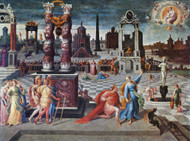Antoine Coypel II (1521–1599)
Published by Therese Myles on 18th Feb 2020
Antoine Coypel II was a French painter born in 1661. He died in 1722 at the age of sixty-one. Antoine Coypel II was indeed an artist that defied many of the popular stereotypes about the famous artists of history. The popular image of the artist is often that of a depressed melancholic that is unappreciated in his or her own time, only to become famous long after he or she would be able to appreciate it. Other stereotypes of artists focus on the artists that are popular and successful in their own time, but become completely forgotten after they died, despite being well-liked and charismatic individuals throughout their lives. To a certain extent, Antoine Coypel II got to enjoy the best of both worlds.
His work is still remembered and displayed today, and he had a very successful life as an artist and an academic. Like many historical artists, Antoine Coypel II lived in a world in which it was very difficult to advance socially and economically without being born into the right family. He was fortunate enough to have been the son of renowned French painter Noel Coypel I. Among other things, Noel Coypel I was the director of the French Academy in Rome, so Antoine Coypel II was very much at the right place in the right time. Antoine Coypel II more or less became his father's apprentice, and managed to get an important head-start in life as a result. Still, Antoine Coypel II was a talented individual who made the most of his advantages in life.
He displayed considerable artistic talent even as a boy, and studied famous art styles in northern Italy when he was only a teenager. Antoine Coypel II achieved success fairly early in life, and his career only continued to expand. He joined the French Royal Academy in 1681 and was directing the Academy by 1714. Between 1681 and 1714, he rose through the ranks as an adjunct professor, a professor, and an adjunct rector, excelling all the while. By 1715, he was working as the king's first painter, which was one of the most distinguished honors that any artist at the time could achieve.
Antoine Coypel II was primarily a history painter. For many artists, particularly those experimenting with new techniques, the style of the painting is significantly more important than the actual content. A simple landscape depicting a very well-known area can become a famous painting if it is portrayed using a distinctive enough style. For history painters, the content of the painting is just as important. They are using their talents in order to illustrate parts of narratives, so they have to put a lot of effort into portraying the individuals involved convincingly. History painting was very prestigious during Antoine Coypel II's lifetime. Its popularity has waxed and waned over the years, but many people today find the large and often epic history paintings more compelling than many of the comparatively simple portraits and still life paintings favored by other artists.
Still, the style of Antoine Coypel II's paintings was certainly notable. His work helped maintain the popularity of the Baroque style itself, which had a profound influence on the historical development of French art. All artists are influenced by other artists, and Antoine Coypel II's style owes a bit to Nicolas Poussin and Peter Paul Rubens. He kept the work of many Bolognese artists alive in a subtle manner that helped establish his continuity with the rest of the history of European art. Antoine Coypel II was deeply important to the progression of art in Europe, and he got to enjoy the fruits of his labor during his own lifetime. His son Charles-Antoine Coypel got to help carry on his father's legacy after Antoine Coypel II's death.

